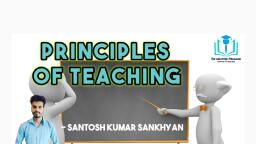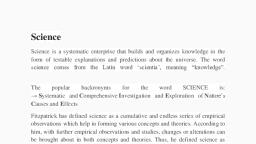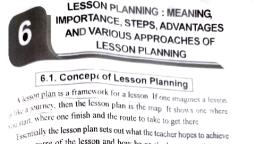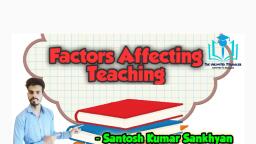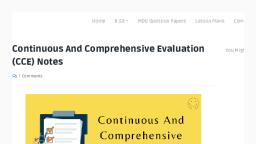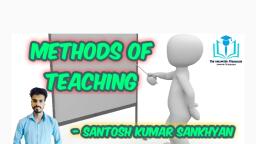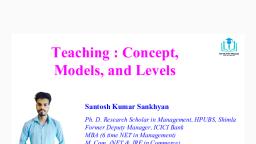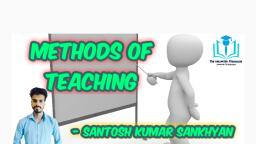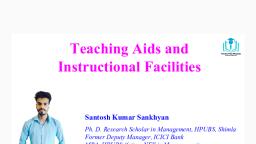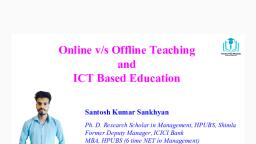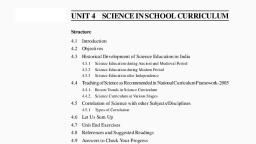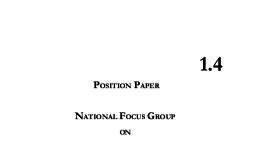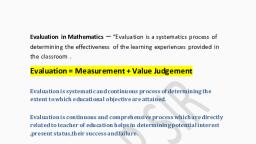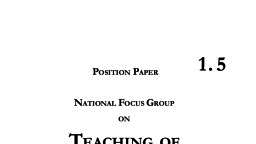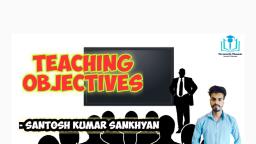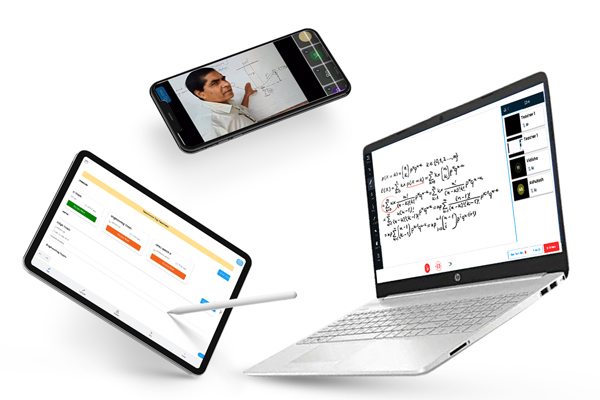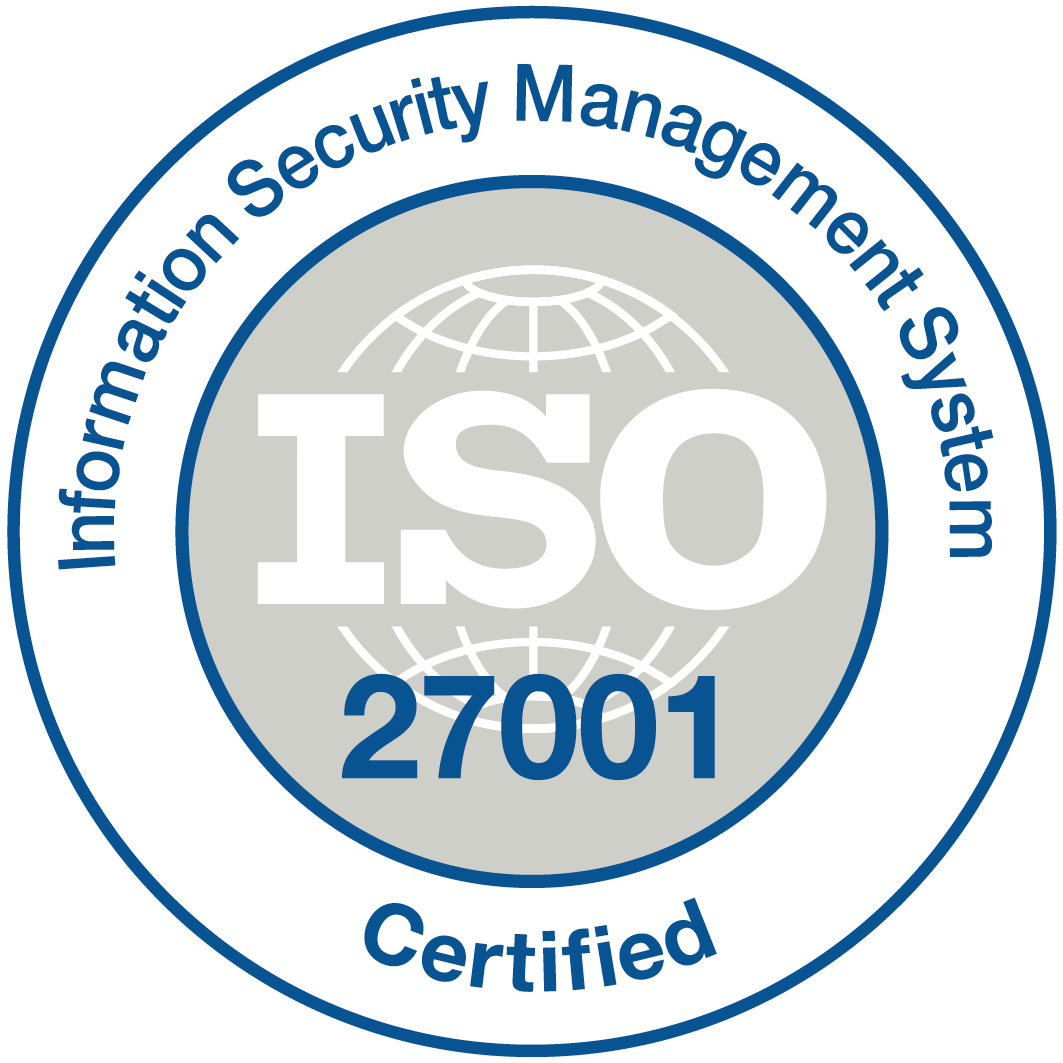Page 1 :
H C Morrison:- Teaching is an intimate contact between the, , UNIT 7: CONCEPT OF TEACHING, , more mature personality and a less mature one., , Meaning, definitions, criteria for teaching – teaching an, art or a science? – relationship between teaching and, , Jackson: - Teaching is a face to face encounters between two, , learning – analysis of the concept of teaching - teaching, , or more persons, one of whom (teacher) intends to effect, , as a deliberately planned process: analysis in terms of, , certain changes in the other participants (students)., , teaching skills – general model of instruction – Preactive, Interactive and Post active phases and teachers, , J B Hough and James K Duncan: - Teaching is an activity with, , role in them., , four phases, a curriculum planning phase, an instructing, phase,, , Teaching is a process in which one individual teaches or, , and, , an, , evaluating, , phase., , instruct another individual. Teaching is considered as the act, , This definition presents the organizational aspect by which we, , of imparting instructions to the learners in the classroom, , can describe and analyze the teaching process., , situation. The main function of teaching is to make learning, effective. The learning process would get completed as a result, , N.L.Gage (Democratic point of view):- Teaching is, , of teaching. So, teaching and learning are very closely related., , interpersonal influence aimed at changing the behaviour, potential of another person., , Dewey: - considers it as a manipulation of the situation,, where the learner will acquire skills and insight with his own, , (5) Clerk: - Teaching refers to activities that are designed and, , initiation., , performed to produce in student’s behaviour., , DEFINITIONS:1, , S.SENDIL VINOD, PRINCIPAL, CCE, PY.
Page 2 :
We can define teaching according to the following three, , •, , viewpoints., , first memorized and then understand, , (a) Authoritarian, , •, , Such teaching is known as thoughtful teaching., , •, , According to this point of view, teaching is an, , (b) Democratic, , interactive process, primarily involving classroom talks, which take place between teachers and student., , (c) Liassez faire., , •, , •, , According to this viewpointTeaching is an activity of memory level only, , •, , This teaching does not develop thoughts and attitude, Is known as thoughtless teaching, , •, , This teaching is teacher’s centric criticism of the, , Here students can ask the questions and selfdisciplined is insisted., , (c) Laissez Faire Attitude:-, , in the students., •, , Here students can ask questions and criticize the, teachers., , (a) Authoritarian:-, , •, , Memory level teaching is the prerequisite (concept) is, , •, , It is known as reflective level teaching., , •, , It is more difficult then memory level and, understanding level of teaching., , •, , teachers., , Memory level and understanding level teaching are, must for the reflective level of teaching., , (b) Democratic teaching:According to this•, , •, , It is highly thoughtful activity., , •, , In this level both students and teachers are, participants., , Teaching is done at understanding level., 2, , S.SENDIL VINOD, PRINCIPAL, CCE, PY.
Page 3 :
•, , This level produces insights., , (4) Teaching is a process of development and learning., (5) Teaching causes a change in behaviour., , NATURE AND CHARACTERISTICS OF TEACHING, , (6) Teaching is art as well as science., (7) Teaching is face to face encounter., , Teaching is a social and cultural process, which is, , (8) Teaching is observable, measurable and modifiable., , planned in order to enable an individual to learn something in, , (9) Teaching is skilled occupation: - Every successful teacher is, , his life. We can describe the nature and characteristics of, , expected to know the general methods of teaching-learning, , teaching in following way:-, , situations., , (1) Teaching is a complete social process, , (10) Teaching facilitates learning, , Teaching is undertaken for the society and by the society., , (11) Teaching is both conscious and an unconscious process., , With ever changing social ideas, it is not possible to describe, , (12) Teaching is from memory level to reflective level., , exact and permanent nature of teaching., , (13) Teaching is a continuum of training, conditioning,, , (2) Teaching is giving information, , instruction, and indoctrination., , Teaching tells students about the things they have to know, and students cannot find out themselves. Communication of, knowledge is an essential part of teaching., (3) Teaching is an interactive process, Teaching is an interactive process between the student and, CRITERIA FOR TEACHING, , the teaching sources, which is essential for the guidance,, progress, and development of students., 3, , S.SENDIL VINOD, PRINCIPAL, CCE, PY.
Page 4 :
Teaching is considered as an effective when the following, , Teacher must try to understand the uniqueness of every, , criteria are fulfilled some of the important criteria of your good, , child and give education keeping in mind these individual, , teaching are..., , differences., , 1. Proper planning, , 5. Sympathetic, , Planning is done in the pre-active face of teaching where, , The teacher creates an atmosphere of sympathy,, , teacher decides teaching strategies, subject matter, method of, teaching,, , teaching, , learning, , materials, , are, , acceptance and understanding., , planned, , 6. Cooperative, , appropriately., , Teaching is good when the teachers not only instruct, , 2. Arouse the interest of learn, , students but also discuss and offered suggestions to the, , A good teaching motivates and creates strong desire for, , students., , self –learning., , 7. Democratic atmosphere, , 3. Give necessary information, , Teaching must be democratic where students can, , The teacher should provide necessary information to the, , involve in teaching learning process without any kind of fear., , students in a very systematic and organised manner., , 8. Progressive, , 4. Individual differences, , Teaching is concerned with the progress of students’, behaviour, attitude, skills etc,, , 4, , S.SENDIL VINOD, PRINCIPAL, CCE, PY.
Page 5 :
9. Remedial measures, , Teaching requires both art and science. They both play, a role in each other because if a teacher demonstrates only one, , Good teaching is both diagnostic as well as remedial., , of these types of teaching, they cannot do effective teaching., , 10. Good teaching is dynamic and not rigid., Teaching as an Art, Teaching as an Art exhibits ways in which the teacher, , TEACHING AN ART OR A SCIENCE?, , uses creative ways to teach the students and so the students, Teaching contains two major concepts of learning, the, , find it to be fun and interesting to learn. It is alleged that even, , Art and the Science. In teaching, Art is defined as “the product, , though when using the artistic methodology to teach the, , of creating human activity in which material is shaped or, , students, the teachers must know the subject themselves and, , selected to convey an idea, emotion or in a visually interesting, , research the material well before they begin to teach., , form”., As a teacher, they need to determine the methods and, This describes exactly what a teacher does. While in, , strategies that work best for them. Teachers are not, , teaching, science is defined as, “a study of anything that can be, , standardized products. What works for one teacher, might not, , tested examined or verified”. The teacher is always studying, , work for another. Thus, all the teaching strategies a teacher, , the situation and examining what they can do. Teaching is, , learns should be adopted and adapted to meet particular, , hence both, an Art and Science., , teaching situation and their personal teaching style. A teacher, must carve out their own teaching philosophy and discover, their own unique talents and learn how to use them., 5, , S.SENDIL VINOD, PRINCIPAL, CCE, PY.
Page 6 :
Teaching is a Science, , Teaching as an art and science, , Teaching is a Science that demonstrates ways in which, , For effective teaching, a teacher must integrate both Art, , the teacher may employ a more logical approach to deliver the, , and Science while teaching in the classroom. The teacher who, , material to the students. It is a sort of traditional way of, , doesn’t apply scientific knowledge to teach the students runs, , teaching in which teachers teach their class., , the risk of using the methods and principles of ineffective, teaching. If a teacher is able to balance both Art and Science, it, , An example of this could be a teacher lecturing their, , will make it easier for the students to learn and assimilate the, , class on the topic being discussed. This type of teaching tends, , information while keeping their attention., , to be monotonous and boring and the teacher faces a harder, time keeping the student’s attention. However, any type of, , Thus, a teacher cannot be called efficient unless he/she, , teaching needs a scientific background or base., , is able to incorporate both the Art and Science of teaching. To, be an effective teacher, one must not only stay abreast of the, , Teaching is a Science as the teachers collect data by, , latest research and findings in the field of education, but they, , observing to see if the learning is taking place and how the, , must also continually practice the art of applying this, , students can best learn. Much like scientists, teachers, , information. Hence, it can be concluded from the above that, , experiment with new strategies or techniques to see how they, , teaching is both, an Art and Science., , work., , 6, , S.SENDIL VINOD, PRINCIPAL, CCE, PY.
Page 7 :
RELATIONSHIP, , BETWEEN, , TEACHING, , classrooms, lessons, and of course, teachers who point out, , AND, , various information., , LEARNING, Teaching and learning are vital processes in survival as, , Hence, it is the act of communicating ideas, emotions,, , they comprise the very foundations of growth. Both of these, , and/or skills to learners or students. Teachers focus on, , methods are necessary in achieving development by seeking to, , students or pupils’ experiences and facilitate situations to, , actualize significant changes in behaviours., , ensure learning., Commonly, there are two forms of teaching:, , Equally, they have various styles and theories that guide, the education system. They are also essentially interconnected, , •, , in a way that you have to learn something before you can, , Formal, , Classroom-based instruction which is facilitated by licensed, , actually teach it and that the act of teaching can make you learn, , professionals falls under formal teaching. It is governed by, , something., , educational systems that have to follow certain curricula, class, hours, and related standards., , Ergo, teaching and learning are highly crucial and, related progressions., , •, , Informal, , Teaching that occurs outside the regulations of the, , What is teaching?, , classroom and does not require licensing is categorized as, Teaching, , came, , from, , the, , Old, , English, , word, , informal. Examples of these are home-based or outside-school, , “tǣcan” which means “to show” or “point out”. Perceptibly,, , tutorials., , when you hear the word “teach”, you often think of, 7, , S.SENDIL VINOD, PRINCIPAL, CCE, PY.
Page 8 :
What is learning?, , •, , Positive or negative, , Ideally, an individual should change positively after being, The term learning originated from the Old English word, , taught. However, it is a well-known fact that negative, , “leornian” which is translated as “to get knowledge” or “to, think, , about”., , Indeed,, , people, , learn, , by, , behaviours are commonly learned., , getting, Brought about by experience, , new knowledge and when they gain insights from thinking, , •, , about something., , It should also be noted that learning is not due to passive, causes such as illness, maturation, and injury., , Specifically, learning is the acquisition of new information, or the modification of existing knowledge, preferences,, , Teaching-learning is a process through which the teacher,, , expertise, and other aspects of behaviour. The following are the, , the learner, the curriculum and other variables are organized, , criteria of learning:, , in a systematic manner in order to attain the pre-set goals., , •, , Teaching as Intentional Activity “teaching is undertaking, , More or less permanent change, , certain activities the intention of which is to induce learning., , Genuine learning is characterized by an individuals’ change, in behaviour which lasts for a fairly long time. For instance,, , A teacher teaches with anticipation that certain activities, , students who get zero in a quiz or test are often perceived to, , will result in learning, but not guarantee it., , have not learnt anything from the lessons as the new, , Teaching is the process of carrying out those activities that, , knowledge was not retained after the teaching process., , experience has shown to be effective in getting students to, learn., , 8, , S.SENDIL VINOD, PRINCIPAL, CCE, PY.
Page 9 :
ANALYSIS OF THE CONCEPT OF TEACHING:, , PRINCIPLES OF EFFECTIVE TEACHING, , The teaching process has three main functions as follows:, , 1. Encourage faculty-student contact., , • 1. Diagnostic function., , 2. Encourage co-operation among students., , • 2. Prescriptive function., , 3. Encourage active learning., , • 3. Evaluative function., , 4. Prompt feedback., 5. Emphasize time on task., , EFFECTIVE TEACHING • William H Burton (1958) states the, following steps towards effective teaching:, , 6. Communicate high expectation., , 1. Teaching should be related to learning., , 7. Respect diverse talents & ways of learning., , 2. Appropriate teaching conditions should be generated for an, , RELATIONSHIP BETWEEN TEACHING & LEARNING, , effective learning., , 1. Both teaching & learning may be formal or informal., , 3. Teaching strategies & tactics should be selected in such a, , 2. Both are goal oriented., , manner as to achieve the goals., , 3. Good teaching results in good learning., , 4. The teacher must understand the relationship of teaching, and learning in order to make the process a successful one., , 4. One can observe teaching but not learning., , 9, , S.SENDIL VINOD, PRINCIPAL, CCE, PY.
Page 10 :
3. Dependence in Teaching and Learning, , 5. Both teaching and learning require skills, creativity, and, intelligence and operate on definite principles., , For the teaching process to be actualized, teachers need to, , 6. Good teaching requires good communication skill & good, , have students as recipients of novel knowledge. On the other, , learning requires good listening skills., , hand, learners do not always need teachers to learn something, as mere solitary experiences can bring about realizations;, , 7. Only good learners become good teachers., , hence, learning., , Differences between Teaching and Learning, , 4. Expertise in Teaching and Learning, , 1. Goal of Teaching and Learning, , Teaching is characterized by a higher level of expertise as, compared to learning., , The primary goal of teaching is to impart knowledge and to, monitor, , change, , in, , behaviour while learning, , aims, , to, , 5. Curiosity in Teaching and Learning, , understand and apply knowledge. A teacher seeks to share, what he knows whereas a learner intends to receive new, , The learning process is improved by piquing students’, , information., , curiosity. Alternatively, the teaching process is improved by, looking for a way to arouse learners’ curiosity., , 2. Authority in Teaching and Learning, , 6. Feedback in Teaching and Learning, , As compared to learners, the teachers possess higher, authority., , Generally, teaching helps others by observing and aptly, pointing out which behaviours should be retained and altered, 10, , S.SENDIL VINOD, PRINCIPAL, CCE, PY.
Page 11 :
10. Autonomy in Teaching and Learning, , while the learning undertaking is marked by being able to, understand the feedback as well as apply it to future, , The teaching course is more imbued with autonomy as, , behaviour., , compared to the learning exercises. For instance, students, , 7. Extent (with respect to existence) of Teaching and, , usually have to ask the permission of the teacher before, , Learning, , engaging in a certain class-related behaviour., , Largely, learning is possible until our last breath. As for, , 11. Performer of Teaching and Learning, , teaching, people can still learn from the teachings of someone, In a typical classroom setting, the act of facilitating the, , who has already passed away., , lessons is performed by the teacher while the learners, 8. Directive in Teaching and Learning, , are responsible for acquiring knowledge., , Essentially, learning cannot be mandated. Students are, , 12. Consciousness in Teaching and Learning, , directed to study but the act of learning is more of an internal, Most often, the teaching process is a conscious task while, , process. On the contrary, teaching can be assigned and verified, , learning can be conscious as well as unconscious. For example,, , through syllabi, lesson plans, curricula, and the like., , we usually learn to fear something from a negative experience, 9. Population in Teaching and Learning, , from the past especially during childhood. An acrophobic,, someone who is irrationally scared of heights, may not be, , As compared to learners, the population of teachers is often, , aware that he has the condition because he fell from a ladder, , less. There are usually fewer individuals involved in the, , when he was a toddler., , teaching process than those at the learning end., 11, , S.SENDIL VINOD, PRINCIPAL, CCE, PY.
Page 12 :
Summary of Teaching and Learning, •, , TEACHING AS A DELIBERATELY PLANNED PROCESS:, , Teaching and learning are interconnected key players in, , A key aspect of effective teaching is having a plan for, , achieving significant change regarding individuals’, , what will happen in the classroom each day. Teaching and, , holistic improvement., •, , Teaching is the process of imparting information., , •, , Learning is the process of receiving knowledge as, , learning should be well planned with clear objectives that are, understood by learners., , evidenced by a positive or negative change which lasts, , •The approaches to teaching and learning should engage all, , for a fairly long time., •, , learners, encouraging them to be active partners in the process., , Teaching is attributed with more authority, autonomy,, and expertise., , •, , •The activities should be relevant to the needs of learners and, , Teaching as a process needs learners while learning can, , to the programme they are following., , happen even without teachers., •, , Teaching is concerned with giving feedback while, , •Creating such a plan involves setting realistic goals, deciding, , learning progresses by understanding feedback., •, , how to incorporate course textbooks and other required, , A teacher who already passed away can still influence, , materials, and developing activities that will promote learning, , others while learning stops when life ends., •, , Unlike studying, learning cannot be mandated while the, , •This means that teaching learning sessions should:, , act of teaching can be covered by a directive., •, , Meet individual learning needs;, , There are more learners as compared to teachers, 12, , S.SENDIL VINOD, PRINCIPAL, CCE, PY.
Page 13 :
Contain activities that motivate and engage all, STEPS OF PLANNING:, , learners, whatever their age, ability and cultural, , • Effective planning is the basis of successful teaching., , background;, , Planning begins with the goals of a particular, Make clear links between schemes of work and, , teaching-learning situation;, , individual session plans; and thus a teacher who is, , Encompasses means of attaining those goals,, , prepared is well on his/her way to a successful, , including materials and activities;, , instructional experience., , And terminates with effective procedures for, evaluating the degree to which the instructional goals, , ANALYSIS IN TERMS OF TEACHING SKILLS, , have been achieved., , Planning is important because how we teach is as, , • Good planning has the potential to build confidence,, , important as what we teach., , and make a teacher feel more secure in lesson execution., , PURPOSE OF PLANNING:, The purposes of planning include:, , TYPES OF PLANNING:, , • Clarification of the objectives to the pupils,, , Basic types of planning include:, , • Provision for individual differences,, , Long-range plans for the year or semester, , • Development of means for stimulating interest,, , Plans of units of work relating to the larger plan and, , • Provision for a logical instructional sequence,, , Plans for each day’s work, , • Provision for flexibility, and, , -- All contributing to the accomplishment of the major, , • Enabling the teacher to teach with confidence., , objectives of education., 13, , S.SENDIL VINOD, PRINCIPAL, CCE, PY.
Page 14 :
opportunities for establishing good working relationships and, Co-operative planning:, , guiding the growth of the student teacher. Elements of, , Although the preparation of actual plans is regarded as, , planning:, , the primary responsibility of the student teacher, it must be, , • Statement of objectives, which clearly shows what is to, , viewed as a team effort action. Thus, the mentor teacher plays, , be taught and the outcomes to be achieved, expressed in, , a critical role in planning for teaching. A wide range of, , terms of pupil learning;, , activities may be included in the planning process, such as,, , • Statement of activities, a logical step-by-step sequence, , • The mentor teacher: serving as an exemplar of well, , of, , planned teaching;, , instruction,, , necessary, , transition,, , and, , an, , appropriately developed ending;, , • Furnishing basic planning instruction;, , • List of materials to be used;, , • Encouraging, and, , • Assessment, including at least two types of, , • If necessary, insisting on planning being done;, , assessment:, , • Critiquing student prepared plans;, , assessment of the teaching procedures., , • Recommending modifications;, , • Title of the lesson, , • Using the plans as a basis for objectifying observations;, , • Time required completing the lesson, , and, , assessment, , of, , pupil, , learning,, , and, , • List of objectives which may be behavioural objectives, • Helping the student evaluate his or her instructional, , (what the previous lessons student can do at lesson, , efforts within the context of the pre-prepared plans., , completion) or knowledge objectives (what the student, , In other words, careful, cooperative planning involves, instruction, , and, , offers, , the, , mentor, , teacher, , knows at lesson completion), , excellent, 14, , S.SENDIL VINOD, PRINCIPAL, CCE, PY.
Page 15 :
• The set (or lead-in, or bridge-in) that focuses the lesson, , “Instructional, , Models, , are guidelines, , or, , sets, , of, , students on the lessons skills or concepts—these List of, , strategies on which the approaches to teaching by instructors, , required materials include showing pictures, which or, , are based. Effective instructional models are based on learning, , models, asking leading questions, or reviewing., , theories. Learning Theories describe the ways that theorists, , An instructional component that describes the sequence, , believe people learn new ideas and concepts., , of events that make up the lesson including the teachers, , An instructional design model provides guidelines to, , instructional input and guided practice to students to, , organize appropriate pedagogical scenarios to achieve, , try new skills or work with new ideas., , instructional goals. Instructional design can be defined as the, , • An evaluation component, a test for mastery of, , practice of creating instructional experiences to help facilitate, , instructed skills or, concepts—such as a set of questions, , learning most effectively., , to answer or a set of instructions to the follow, • Analysis component the teacher uses to reflect on the, , Instructional models are related to theories about how, , lesson itself —such as what worked, what needs, , we learn. Some examples include: behaviourism, cognitivism,, , improving, , constructivism, and connectivism. Various learning theories, , • A Summary where the teacher wraps up the, , fit within these general categories, i.e., adult learning theory,, transformative learning, social interaction, motivation theory,, , discussion and answers questions, , etc., , • A continuity component reviews and reflects content, from the previous lesson., , Behavioural Systems, , GENERAL MODEL OF INSTRUCTION –, 15, , S.SENDIL VINOD, PRINCIPAL, CCE, PY.
Page 16 :
The focus of the methods associated with this category, , principles, , and, , theories, , is on observable skills and behaviours. These methods have, , Concept Attainment--focus on categorizing, concept, , generally proved more likely to positively impact scores on, , formation,, , standardized tests of basic skills than models in other, , Intellectual Development--based on the cognitive, , categories., , developmental theory of Jean Piaget, , and, , concept, , attainment, , Personal Development, , Direct Instruction-- highly structured, teacherdirected; maximization of student learning time., , The focus of these models is on those outcomes held in, , Mastery Learning-- given enough time and quality, , high regard by humanistic educators: high self-concept, , instruction, nearly all students can master any set of, , and, , objectives, , self-esteem;, , independence;, , positive, , creativity, , self-direction, , and, , curiosity;, , and, , and, , the, , development of affect and emotions. Most of the, , Information-Processing Approaches, , methods used are associated with open education., , The focus of the methods associated with information, , While these models have not demonstrated an ability to, , processing approaches are more linked to concepts and, , impact outcomes associated with traditional education,, , principles developed in cognitive psychology. Many of the, , they do show promise in impacting other outcomes, , tests used to measure school learning are being modified so, , important for the information age., , that they consider important mental processing skills that these, models are designed to address., , Facilitative teaching- -student-cantered; based on the, methods, , Inquiry Training/Inductive Thinking--focus on concept, , of, , Carl, , Rogers, , Increasing Personal Awareness--focus is on developing, , formation, interpretation of data, and formation of, 16, , S.SENDIL VINOD, PRINCIPAL, CCE, PY.
Page 17 :
an awareness and fulfilment of individual potential, , considered in terms of various steps and the steps constituting, , Synaptic--focus on the development and application of, , the process are called phases of teaching. Philip W Jackson, , creativity, , thinks that if we are to obtain a complete description of the, teaching activity, we must consider what the teacher does, , Social Interaction, , before and after the regular teaching in the class. Jackson, , The models associated with the social interaction family, , analyses the teaching systematically in three steps-, , are focused on developing the concepts and skills needed to, , 1., , Pre-active phase of teaching, , ability to impact standard achievement measures as well as, , 2., , Interactive phase of teaching, , group interaction., , 3., , Post-active phase of teaching, , work in groups. Cooperative learning has demonstrated, , Cooperative Learning--, , focus is on working in, , groups; based on the methods of Slavin and Johnson, and, , Johnson, , Role playing--focus is on the study and development of, social behaviour and values., , PRE-ACTIVE, INTERACTIVE AND POST ACTIVE, PHASES AND TEACHERS ROLE IN THEM., Teaching is complex task, to make this job easy and, successful, a systematic planning is needed. Teaching is to be, 17, , S.SENDIL VINOD, PRINCIPAL, CCE, PY.
Page 18 :
sections of a textbooks etc. the phase is therefore called the, planning stage., In pre-active stage following operations or sub-stages are, involved:, Formulating or fixing up the goals- First of all, the, , 1., , teacher formulates the teaching objectives in behavioural terms, by using taxonomy of educational objectives. These objectives, are of two typesI] in the form of entering behaviour of pupil., II] In the form of terminal behaviour of pupils., 1., , PRE-ACTIVE PHASE OF TEACHING:, , Decision making about the content: After fixing, , 2., , Pre-active phase as the name implies is concerned with, , the goals, the has to arrange the sub-contents in a logical, , the preparation of teaching. Before actual classroom teaching, , sequence in such a way that it should function empirically., , or what Jackson calla “calm” part of teaching, a teacher has to, , Content should be so arranged that it facilitates transfer of, , perform many tasks. These tasks include such as preparing, , learning., , lesson plans, arranging furniture and equipment within, , 3., , classroom, manning papers, studying test reports, reading, , teaching: Here the teacher select appropriate strategies and, , Decision, , making, , about, , the, , strategies, , for, , tactics keeping in view the content and level of the pupils with, 18, , S.SENDIL VINOD, PRINCIPAL, CCE, PY.
Page 19 :
II-, , help of which the contents can be marked on the brain of pupils, very easily., 4., , III-, , Diagnosis of the class;, Action and reaction of achievement, , Developing teaching strategies for specific, , subject matter: Decision making about the teaching methods, , I} Sizing up of Class: As the teacher enters the classroom, he, , and strategies for presenting the content is not sufficient but, , perceives the size of the class and throws his eyes on all the, , the teacher is also to decide how and when he will make use, , pupils. He locates which faces are discouraging, encouraging, , of which method and strategy during classroom teaching., , etc. in this way, he tries to size up the class group before, teaching. Similarly, the students also size up the personality of, the teacher in a few seconds. Hence, at this stage the teacher, , 2. INTERACTIVE PHASE OF TEACHING:, , must look like a teacher first. He should posses all those, , This is actual classroom teaching. It includes all those, , qualities which are supposed to be present in a good teacher., , behaviour and activities which a teacher uses after, , II} Diagnosis of learners: The teacher tries to diagnose the, , entering the classroom., , level of achievement in his students in three areas-, , The teacher provides pupil’s verbal stimulation of various, kinds. “makes explanations, ask questions, listens to student’, responses and provides guidance” P.W Jackson., The phase includes the following operations:, I-, , A-, , Abilities of the learners:, , B-, , Interests and attitudes of learners:, , C-, , Academic background of learners:, , Sizing up of class, , 19, , S.SENDIL VINOD, PRINCIPAL, CCE, PY.
Page 20 :
This may done by asking some questions or enquiring about, , which increase the possibility of occurrence of a particular, , the matter., , response are termed as feedback or reinforcement. These, conditions may be of two types:, , III} Action and reaction of achievement:, , 1., , This involves the following operations or sub stages:, , Positive reinforcement- these are the conditions, , which increases the probability of re-occurring of desirable, A-Selection and presentation of stimuli-, , response of behaviour e;g praise, appreciation, reward,, , The stimuli in the action or activity of teaching can be, , knowledge of result etc., , verbal or non verbal, the teacher should be aware of the motive, , 2., , which is an appropriate stimulus or which is irrelevant stimuli, , Negative reinforcement- the conditions which, , decrease the probability of re-occurring the undesirable, , in that particular teaching situation. The teacher should select, , response or behaviour e;g reproof etc., , the appropriate stimulus as soon as the situation arises and an, Reinforcement is used for three purposes. these are i} for, , effort should be made to control the undesired activities to, , strengthening the response, ii} for changing the response and, , create the situation and for desired activities. After selecting, , iii} for modifying or correcting the response., , the stimuli, the teacher should present them before the pupils., The teacher must know three things in presenting the stimuli:, , C-, , i) Form II) content and iii) order of sequence., , Deployment of strategiesAt the time of interaction the teacher produces such, , B- Feedback and reinforcement:, , activities and conditions by the reinforcement strategies which, affect the activities of pupils. The deployment of the teaching, , It increases the probability that a particular response, , strategies turns the pupil-teacher interaction impressive. The, , will be repeated in future. In other word, those conditions, 20, , S.SENDIL VINOD, PRINCIPAL, CCE, PY.
Page 21 :
strategies of reinforcing the students and of controlling their, , 1., , verbal and non verbal behaviour are used for imparting the, , Assessing the suitability of objectives, , determined., , subject content effectively while a teacher teaches in classroom., , 2., , Decision regarding re-teaching the content, , or further taking up the content., 3. POST – ACTIVE PHASE OF TEACHING:, , 3., , Assessing the suitability of the instructional, , material and aids., , This phase is also known as evaluative stage. It provides, necessary feedback to the teacher and the student in bringing, , 4., , the desirable improvement in their improvement in their, , Assessing the impact of the classroom, , environment., , performance. It is related with both teaching and learning. The, teacher analyses as to what extent the students have grasped, ****************, , the material presented to them. The teacher is able to see, whether the methods and strategies used by him were, successful and if so to what extent. It helps the teacher to teach, things better in future. It also helps student to learn things, better. It helps the teacher to decide whether he should proceed, with the new contents or re-teach what has already been, taught., Following are the main operations at this stage-, , 21, , S.SENDIL VINOD, PRINCIPAL, CCE, PY.

